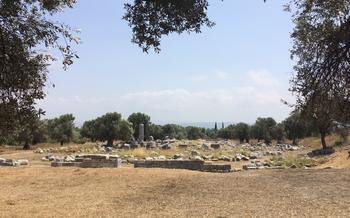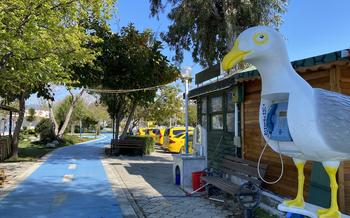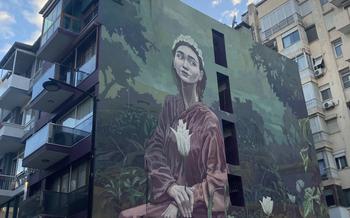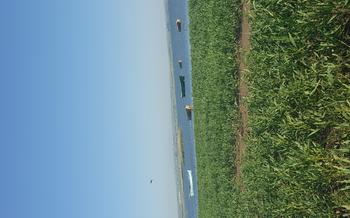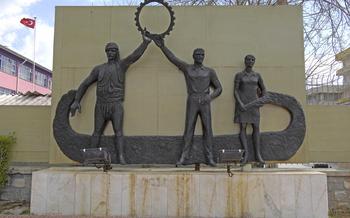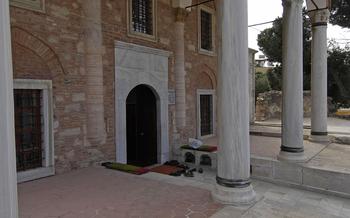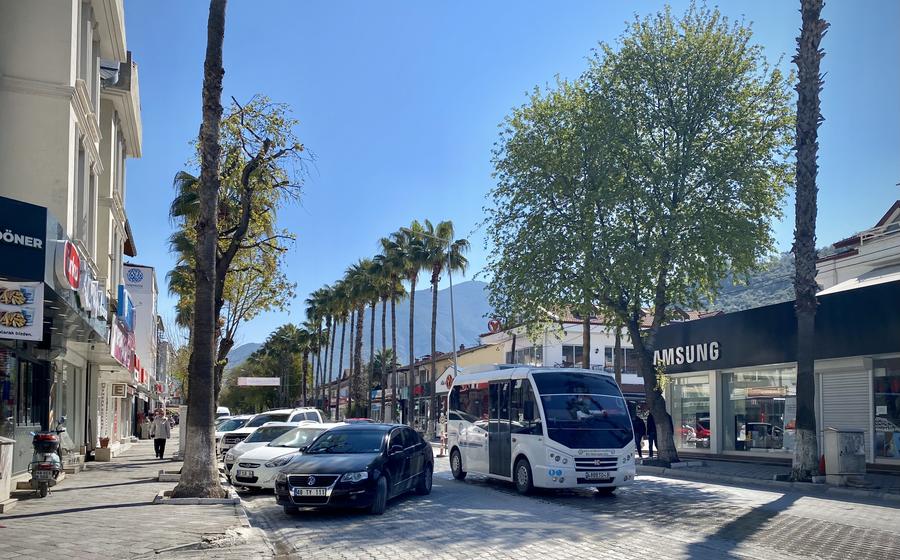
Amos Ancient City
- Historical Background
- Getting There
- Entrance Fees and Opening Hours
- Exploring the Ruins
- The Agora
- The Temples
- The City Walls
- The Museum
- Local Cuisine
- Accommodation Options
- Other Nearby Attractions
- Shopping and Souvenirs
- Photography Opportunities:
- Insider Tip
Historical Background
Amos Ancient City, nestled in the picturesque region of Muğla, Turkey, holds a significant place in history as a prominent port city during the Roman Empire. Its strategic location along the Mediterranean Sea made it a vital hub for trade and commerce, connecting the East and the West. The city's well-preserved ruins, including the agora, theater, temples, and city walls, offer a glimpse into its glorious past.
Amos's strategic location was crucial for the Romans, as it allowed them to control the lucrative trade routes between the Mediterranean and the Aegean Sea. The city served as a gateway for goods from distant lands, such as spices from the East and wine from Greece.
One of the most intriguing aspects of Amos is its association with famous historical figures. The renowned Roman orator, Cicero, visited the city during his governorship of the province of Asia. His writings provide valuable insights into the city's political and social life during the 1st century BC.
The ruins of Amos stand as a testament to its rich history and architectural prowess. Explore the ancient city and step back in time to experience the grandeur of the Roman Empire.
Getting There
Reaching the Amos Ancient City is a convenient and accessible journey from major cities in Turkey. The city's strategic location makes it well-connected by various transportation options.
To arrive by bus, regular services depart from major cities like Izmir, Antalya, and Fethiye. The journey takes approximately 2-3 hours, depending on the starting point. Buses offer a comfortable and affordable mode of transport, with fares ranging from 50 to 80 Turkish Lira.
Alternatively, visitors can opt for train travel, with services available from major cities like Izmir and Ankara. The train journey offers scenic views of the countryside and is a relaxing way to reach the Amos Ancient City. Travel time by train can range from 3 to 5 hours, with fares varying between 75 and 100 Turkish Lira.
For a more flexible and independent travel experience, renting a car is an excellent option. The roads leading to the ancient city are well-maintained, and car rental services are readily available in major cities. Renting a car allows visitors to explore the region at their own pace and venture into nearby towns and villages. Rental costs typically start from 200 Turkish Lira per day, depending on the type of vehicle and rental duration.
The best time to visit the Amos Ancient City is during the shoulder seasons (April-May and September-October) when the weather is pleasant, and tourist crowds are smaller. During the summer months (June-August), temperatures can soar, making it less comfortable for exploring the ruins. However, this period offers the advantage of longer daylight hours for sightseeing.
Entrance Fees and Opening Hours
Entrance Fees: - General admission: 50 Turkish Lira - Reduced admission (students and seniors): 25 Turkish Lira - Free admission: Children under 12 and disabled visitors
Opening Hours: - November to March: 08:00 AM to 05:00 PM - April to October: 08:00 AM to 07:00 PM
Special Events and Festivals: - Amos Festival: Held annually in July, this festival celebrates the ancient city's heritage with traditional music, dance, theater performances, and historical reenactments. - Olive Harvest Festival: Held in October, this festival celebrates the region's olive harvest with food stalls, cooking demonstrations, and cultural events.
Recommended Time of Day to Visit: - Early morning or late afternoon: To avoid the midday heat and crowds, especially during the summer months. - Sunset: To experience the magical atmosphere of the ancient city as the sun sets over the surrounding landscape.
Exploring the Ruins
As you venture through the ancient city of Amos, you'll be greeted by a symphony of ruins, each whispering tales of a bygone era. The agora, once the bustling heart of the city, still echoes with the voices of traders and philosophers. Its colonnades, shops, and public buildings stand as silent witnesses to the vibrant commercial and social life that thrived here.
The theater, a testament to the city's cultural heritage, beckons you to imagine the laughter and applause that once filled the air during performances. Its well-preserved seating arrangement, stage design, and acoustics hint at the quality of entertainment that graced this ancient stage.
Sanctuaries dedicated to various deities line the city's streets, their architectural features still hinting at the religious rituals and ceremonies that took place within their sacred walls. The Temple of Apollo, with its majestic columns and intricate sculptures, stands as a testament to the city's devotion to the sun god.
The city walls, once an impenetrable barrier against invaders, now stand as a symbol of resilience and strength. Their height, thickness, and well-preserved gates speak volumes about the strategic importance of Amos in ancient times.
As you explore these ruins, let your imagination soar. Picture the hustle and bustle of the agora, the vibrant performances in the theater, the solemn ceremonies in the temples, and the vigilant guards patrolling the city walls. Each stone, each fragment, tells a story, waiting to be discovered by the curious traveler.
The Agora
The agora, or central square, of the ancient city of Amos was a bustling hub of activity in ancient times. Here, people gathered for trade, politics, and social interactions. The agora was the heart of the city, where merchants displayed their wares, politicians gave speeches, and citizens met to discuss important matters.
The architectural features of the agora are impressive, with colonnades lining its perimeter, providing shade and shelter to those who frequented the square. Shops and public buildings surrounded the agora, catering to the needs of the city's inhabitants. Among the notable artifacts found in the agora are statues and inscriptions, offering glimpses into the lives and beliefs of the people who once lived here.
One can easily imagine the lively atmosphere of the agora during ancient times. Merchants hawking their goods, politicians swaying the crowd with their oratory skills, and citizens engaged in lively debates about the issues of the day. Perhaps a traveling storyteller would regale the audience with tales of faraway lands, or a musician would entertain the crowd with his melodies.
The Temples
Amidst the ruins of the Amos Ancient City, several temples stand as testaments to the religious beliefs and practices of its inhabitants. These sacred structures, each dedicated to a different deity, offer a glimpse into the spiritual life of the ancient city.
The Temple of Zeus, the king of the gods, is the most prominent among them. Its imposing columns and well-preserved pediments depict scenes from Greek mythology, narrating the tales of Zeus's power and benevolence. Visitors can imagine the grandeur of religious ceremonies held within its walls, where offerings were made and prayers were recited to seek the god's favor.
Another significant temple is dedicated to the goddess Athena, the patroness of wisdom and warfare. Its elegant architecture and intricate carvings showcase the city's artistic prowess. Inside the temple, a statue of Athena once stood, embodying the strength and intelligence that she symbolized. Worshippers would come to the temple to seek guidance and protection in times of conflict and uncertainty.
Smaller temples, dedicated to deities such as Apollo, Artemis, and Dionysus, are also scattered throughout the city. Each temple holds its own unique story, reflecting the diverse religious beliefs and practices of the ancient population. Visitors can explore these temples, marveling at their architectural details and imagining the rituals and ceremonies that once took place within their sacred spaces.
As you wander among these ancient temples, let your mind wander back in time, envisioning the devout worshippers who once sought solace, guidance, and divine intervention within these hallowed walls. The temples of the Amos Ancient City stand as reminders of the deep spiritual beliefs that shaped the lives of its inhabitants, adding a layer of intrigue and mysticism to the city's rich history.
The City Walls
The imposing city walls of Amos Ancient City stand as a testament to the city's strategic importance and resilience. Constructed from massive blocks of stone, these fortifications formed an impenetrable barrier, protecting the city from invaders and external threats. The walls, which once encircled the entire city, featured several gates that allowed for controlled access and egress. These gates, often adorned with intricate carvings and inscriptions, served as ceremonial entrances and defensive checkpoints.
Imagine yourself as a guard, pacing along the wide ramparts of the city walls. The sun beats down on your helmet as you scan the horizon, vigilant for any sign of approaching danger. The walls provide a commanding view of the surrounding landscape, allowing you to keep watch over the city and its environs.
As you make your rounds, you come across a section of the walls that has been partially restored, revealing the original construction techniques employed by the ancient builders. The massive blocks of stone, each weighing several tons, have been carefully fitted together without the use of mortar, showcasing the engineering prowess of the time.
In the distance, you can see the remnants of a fierce battle that once took place at the city gates. The shattered remains of weapons and armor lie scattered on the ground, a silent reminder of the struggles that the city's defenders endured to protect their homes and way of life.
As you continue your patrol, you feel a sense of awe and admiration for the resilience and determination of the people who built and defended this ancient city. The city walls, standing tall and proud after centuries of wear and tear, serve as a symbol of the enduring legacy of Amos and its inhabitants.
The Museum
Within the Amos Ancient City, a treasure trove of history awaits visitors at the museum. This repository of artifacts and discoveries offers a profound glimpse into the lives and culture of the city's ancient inhabitants. As you step inside, you'll be greeted by an array of exhibits that showcase the rich heritage of this once-thriving metropolis.
Among the many fascinating exhibits, you'll find pottery that reveals the artistry and craftsmanship of the city's artisans. Intricate designs and vibrant colors adorn these ceramic vessels, each telling a story of daily life and customs. Coins, minted with the city's emblem, provide a tangible connection to the economic and political systems of the past.
Statues and sculptures, carved with remarkable detail, depict gods, goddesses, and notable figures from the city's history. These works of art offer a glimpse into the religious beliefs and cultural ideals of the ancient Amos people. Inscriptions etched in stone or metal provide valuable insights into the city's laws, governance, and social structure, offering a tangible connection to the voices of the past.
One particularly captivating exhibit is a collection of jewelry and ornaments that once adorned the bodies of Amos's citizens. These exquisite pieces, crafted from gold, silver, and precious stones, showcase the city's love of beauty and personal adornment. Each piece tells a story of individual style and status, whispering secrets of the people who wore them centuries ago.
Local Cuisine
The Muğla region, where the Amos Ancient City is located, boasts a rich and diverse cuisine influenced by Turkish, Mediterranean, and Aegean flavors. Visitors can indulge in fresh seafood, a staple of the region, grilled meats cooked to perfection, and an array of traditional Turkish mezes, small dishes served as appetizers or snacks.
For a true taste of Mugla cuisine, try the freshly caught fish grilled with lemon and herbs, or the succulent shrimp sautéed in olive oil and garlic. Meat lovers will delight in the şiş kebap, tender pieces of lamb or chicken grilled on skewers, or the köfte, flavorful meatballs often served with rice or bulgur.
To complement your meal, sample the mezes, a selection of small dishes that showcase the region's culinary diversity. Try the cacık, a refreshing yogurt-based dip with cucumber and garlic, or the hummus, a creamy chickpea dip flavored with tahini and lemon.
For a memorable dining experience, head to one of the local restaurants or eateries in the vicinity of the ancient city. These establishments offer a warm and welcoming atmosphere, where visitors can savor authentic Mugla cuisine while immersing themselves in the local culture.
Accommodation Options
When planning your visit to the Amos Ancient City, you'll find a range of accommodation options to suit every budget and preference. For a comfortable and convenient stay, consider booking a room at one of the nearby hotels. These hotels offer modern amenities, comfortable rooms, and easy access to the ancient city and other attractions.
If you're looking for a more intimate and authentic experience, guesthouses are a great option. These small, family-run establishments offer a warm and welcoming atmosphere, allowing you to connect with local culture and traditions. Guesthouses often provide traditional Turkish breakfasts and can assist you with arranging tours and activities.
For those seeking a unique and immersive experience, consider renting a vacation home or apartment. These rentals offer the privacy and comfort of your own space, allowing you to fully embrace the local lifestyle. You'll find a variety of vacation rentals available, from cozy cottages to spacious villas, many of which offer stunning views of the surrounding landscape.
To find the best deals on accommodation, it's advisable to book in advance, especially during the peak tourist season. Consider checking online booking platforms, travel agencies, or directly contacting the accommodation providers to compare prices and availability.
Other Nearby Attractions
In addition to the captivating ruins of the Amos Ancient City, visitors can explore a myriad of other attractions in the surrounding area. Nature enthusiasts can bask in the sun-kissed beaches of the Aegean coast, just a short drive from the ancient city. The stunning Datça Peninsula, with its crystal-clear waters and secluded coves, is a haven for swimming, snorkeling, and diving. For those seeking a taste of local culture, the charming village of Bodrum, with its whitewashed houses and vibrant nightlife, is a delightful excursion. History buffs can delve deeper into the region's rich past at the Bodrum Museum of Underwater Archaeology, showcasing an impressive collection of artifacts recovered from shipwrecks along the Turkish coast. Whether you seek relaxation, adventure, or cultural immersion, the environs of the Amos Ancient City offer a diverse array of experiences to satisfy every traveler's whim.
Shopping and Souvenirs
The Amos Ancient City and its surroundings offer a variety of shopping opportunities for visitors looking to take home a piece of their experience. Local markets, souvenir shops, and boutiques line the streets, offering a diverse range of items to suit every taste and budget.
For unique and handmade souvenirs, visitors should head to the local markets. Here, they can find traditional Turkish crafts, such as pottery, textiles, and jewelry, as well as locally produced honey, olive oil, and spices. The markets are a great place to bargain for a good deal and support the local economy.
For those seeking more refined souvenirs, the boutiques and shops in the city center offer a selection of high-quality ceramics, glassware, and artwork inspired by the ancient city's rich history and culture. These shops are perfect for finding unique gifts or special mementos to commemorate your visit.
One of the most popular souvenirs from the Amos Ancient City is a replica of the city's ancient coins. These coins, which feature images of gods, goddesses, and historical figures, are a tangible reminder of the city's rich past. Visitors can find replicas of these coins in many of the souvenir shops in the city.
Whether you're looking for a unique handmade craft, a piece of local art, or a replica of an ancient coin, the Amos Ancient City and its surroundings offer a variety of shopping opportunities to suit every taste and budget.
Photography Opportunities:
The Amos Ancient City is a photographer's paradise, offering endless opportunities to capture stunning images of its ruins, landscapes, and vistas. The well-preserved structures, bathed in golden sunlight, provide a picturesque backdrop for your shots. For panoramic views, climb to the top of the city walls or the theater, where you can capture the entire ancient city spread out before you. For close-up details, focus on the intricate carvings on the temple pediments or the weathered columns of the agora. Experiment with different angles and perspectives to create unique compositions that showcase the city's grandeur. Remember to adjust your camera settings according to the lighting conditions, and use a tripod for stability when shooting long exposures. Whether you're a professional photographer or simply an enthusiast, the Amos Ancient City will provide you with an unforgettable photographic experience.
Insider Tip
-
Venture off the beaten path and explore the lesser-known ruins of the ancient city, such as the hidden temple of Apollo, nestled atop a hill overlooking the sea. This secluded spot offers breathtaking panoramic views and a sense of tranquility away from the main tourist areas.
-
For a unique experience, visit the ancient city during the annual "Festival of Lights," held every summer. The ruins are illuminated with thousands of lanterns, creating a magical and enchanting atmosphere as you wander through the ancient streets.
-
Consider hiring a local guide for a more immersive experience. They can share fascinating stories and historical insights about the ancient city, bringing its past to life and helping you appreciate its significance.
-
Check the official website of the Amos Ancient City or local tourism boards for information on special events or festivals held throughout the year. These events offer an opportunity to experience the ancient city's rich cultural heritage through traditional performances, exhibitions, and reenactments.
